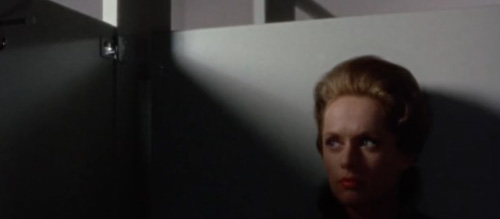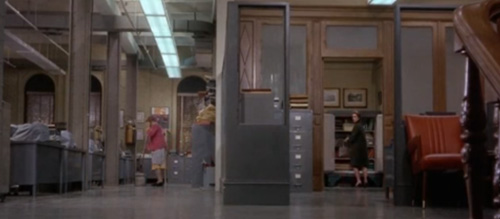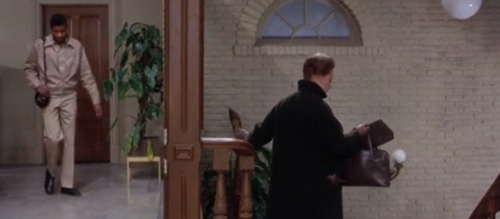Shot For Shot: Safe-Theft Scene in Hitchcock’s ‘Marnie’ (1964)
When settling down for a horror movie to munch popcorn to in the dark, invariably a recommendation that seems to get thrown around is Alfred Hitchcock’s Psycho (1960). But, while it is a classic of the genre and an important film regardless of what type of movie it is, there is another film in Hitchock’s huge filmography that is often overlooked with regards to how masterfully it builds tension: Marnie.
Released a few years after Pyscho, Hitchcock’s Marnie (1964) was more of a tense drama than a thriller, though there are still some typical Hitchcock elements interwoven into the film. About 1/3 of the way through the film comes a truly remarkable scene: a theft from a safe. In this article, the safe theft scene will be dissected shot for shot to establish how it was that Hitchock manipulated his audiences into feeling so on edge in his often overlooked 1964 classic.
Spoilers Ahead!
The Setup: Marnie (Tippi Hedron) is a thief posing under an alias at a company owned by Sean Connery’s character Mark. Worried about the growing intimacy between Mark and herself, Marnie makes the decision to break into his company’s safe, steal as much cash as possible, and then vanish into thin air.
The first shot shows everyone in the company leaving after the end of a working day. Marnie puts on her coat, says goodbye to her colleague Susan, and proceeds to the bathroom. There are several things to notice about the initial tracking shot that follows behind her…
Firstly, it gets us intimately involved with her movements, and then it ties us (at least for this scene) to Marnie. We are with Marnie, and thus it feels like anything that happens to her in the future, happens to us too. This basic establishment of empathy (by establishing the character as a proxy for ourselves) means that if any danger should stalk our heroine, it shall stalk us as well. This subliminal empathy alignment is a fundamental necessity for increasing suspense.
Marnie walks into the bathroom and blanks everyone at the sinks. This sets her apart from the others; she is different, and it’s a different treatment of her colleagues than we have seen with Susan. She silently heads into one of the stalls and Hitchcock cuts to being inside with her, in darkness save for a strip of light piercing over the top of the door and illuminating Marnie’s face. You’ll see this cinematography a lot, a character in darkness save for light across the eyes; think of Orson Welles clapping in the theatre in Citizen Kane. The surroundings suggest the character to be in some kind of danger or trouble, but we still see the emotions on their face reacting to the situation. Hitchcock holds this shot for what seems like an age, Marnie listening for those in the bathroom to leave, then listening outside, and then finally stepping out. It’s nearly a full minute between cuts. As an audience, we’re so used to seeing cuts in films at a regular pace that long takes always throw us off. Waiting and waiting ratchets up that tension like nothing else in the editor’s arsenal.
Marnie steps out of the stall and stands by the sink for a moment before heading out to the main office space. From the moment she leaves the stall to the very end of the scene, the whole thing is devoid of almost any sound at all. Every little sound from now on could be a giveaway, letting someone know that we are here when we shouldn’t be. Sometimes an absence of sound and music is just as effective as having it.
Now we get to the main body of the scene.
We watch Marnie exit the bathroom and check to see if anyone is there. Hitchcock, obeying all his classical film principals, cuts to a POV shot of an empty office on Marnie’s look, and we cut back to her looking behind, subsequently beginning to walk into the office. Hitchcock doubles down on our association with Marnie, and so he uses a POV tracking shot of Marnie checking the cubicles for any workers. He wants us feeling every little tremble of fear, every slight moment of paranoia. We then return to watch Marnie reach into her bag for the key to the drawer where her boss keeps the safe combination, focusing in for a close-up on the key to make sure we know the information is important. Hitchcock is always very economical in that fashion; every shot has a very specific purpose that suits exactly what the story calls for.
The shot returns to a medium and continues to follow Marnie. It doesn’t cut away as Marnie rounds the table, picks up her bag, comes back around, heads over to another desk and uses the key to open it up. Again… long, simple takes show exactly what is happening, drawing out the tension like an elastic band.
Hitchcock cuts to a close-up of the combination as Marnie tracks it down with her hand, slowly, laboriously. Then right back to another close-up of Marnie looking around, the character making sure nobody is there to see her getting the safe combination. There’s nobody there. Phew, we’re safe… for now. Keeping the same shot, the heroine moves to the door to the room where the safe is kept and slips inside. She thinks about closing it, but instead holds it wide open; making sure she’s got a quick getaway if she needs it. This, in turn, sets up the key shot of the whole sequence which comes into play in a moment’s time.
Next is a close-up of Marnie’s hand turning the dial to the safe, and then the next wide is what really makes this sequence stand out…
Here we have a great big wide shot. On the right hand side of the screen is Marnie opening the safe. In the very foreground Hitch makes sure to include the balustrade for the stairs, reminding us of where the exit is. And then, at the moment Marnie swings open the second safe door, on the left hand side of the screen comes the cleaning lady, both characters oblivious to one another.
This kind of two-shot is an absolute classic of Hitchcock’s masterful, economic framing. He presents the character on one side of the screen, and the danger on the other. You see this kind of framing in Psycho with the shadow of Mother through the shower curtain. Much of Rear Window is built on this same technique. In a single shot he applies his ‘bomb theory’, where suspense is built by an audience having knowledge the characters don’t (find a link to an interview with Hitchcock about this at the end of the article). Even if you see nothing apart from this single shot, the way it is framed and designed means that you know exactly what is happening without any context. The shot is held for over 40 seconds, letting the suspense creep and creep as the cleaning lady mops the floor, getting ever closer to us, to blocking our escape, to discovering Marnie at work.
Finally we cut to a close-up of Marnie as she leaves the safe, and stops as she sees the cleaning lady. Here the POV serves doubly, not only to keep us in Marnie’s predicament, but also by showing us exactly where the two characters are in relation to one another. The flat two-shot can’t give us all the information regarding the spatial relationship between them, so this shot serves. We see our threat through the glass, but she can see us too. We’re now incredibly vulnerable, and any slight slip will give the game away. We return to Marnie, and another POV follows, looking for the stairs. It seems so close, and yet we’re still too far away, and we have to risk exposure to get there. Here we have a clear goal, and a clear obstacle stopping us. It’s simple, effective storytelling.
We cut to a medium of Marnie, and pan down as she takes off her shoes and slips them into her pockets. Again it’s all in one shot; if we can keep from cutting, the more we can stretch that elastic band of tension. And then, we track behind her as she begins to step out from the safety of the safe-room and across the office towards the stairs. The sound of water in the mop-bucket keeps us on edge. It’s menacing, all the more so because there are no other noises. All we hear is the constant reminder that danger is right in front of us, and can catch us at any moment.
Hitchcock chooses now to break his routine and goes for quicker, more rapid editing, trying to get our hearts truly pumping; wanting us to run. A quick cut down to Marnie’s feet to remind us of her lack of shoes, and then a close up of her left hand pocket, shoe sticking out. Her feet remind us of the need for silence, and the shoe begins the next danger; it falling out. We return to our tracking with Marnie, and then back to the shoe. It’s definitely further out now, and we realise, sick to our stomach, that she doesn’t know it’s about to fall out. Once again, a danger the character is unaware of, piling on bomb after bomb, all with the potential to explode in our face. A further cut to Marnie walking, eyes focused on not being detected by the cleaner, and another cut to her shoe. It’s almost out now, ready to fall and give us up.
It falls. Our breath catches. We cut to a low angle, camera on the floor, of the shoe hitting the floor with a thud made all the louder by the relative quiet. In the background, the cleaner is specifically positioned. Not only has the noise just given us away, but right in front of the threat we were avoiding, tying both dangers together. Again, economical Hitchcock does it in a single shot.
We cut to Marnie, her eyes wide in horror as she turns to see the shoe on the floor, before looking to see if she has been caught. To our relief, the cleaner is still going, oblivious to us. But does the heart rate stop? Of course not. The shoe falling shows that we’re not invulnerable, that things can go wrong, and she still might turn around and spot Marnie at any given moment. We cut back to Marnie as she quickly, quietly picks up her shoe and heads for the stairs.
In this same shot, Hitchcock gives us a final little heart pump as we hear a door open. Marnie makes it to the stairs with barely a second to spare as a worker comes in from the left hand side of the screen. Once more, the screen is split (this time by the wooden post) to position Marnie in peril on the right hand side of the screen, with this new danger on the left, both again unaware of each other. Marnie descends out of shot and down the stairs as we follow the gentleman to the cleaner, who talks to her loudly with a hand to his mouth to amplify his voice. She was hard of hearing the whole time. Hitchcock uses this to end the scene by deflating our pent-up tension, allowing the next scene to begin from a neutral standpoint, closing it off in a natural and pleasing fashion.
The safe-stealing scene is a perfect example of what made the director so famous. Alfred Hitchcock presents us with a slice of simple, elegant unease, pulling out every trick in the book to get our hearts beating far faster than they should be. There are no killers here, no evil birds; just the simple fear that we, like Marnie, will be caught in a horrifically compromising situation. The graceful efficiency in this scene is what makes it such a delight to watch, and an underappreciated master class in subtle suspense.
Article by Kieran Judge
Twitter: KJudgeMental
A link to a quick interview with Hitchcock discussing his ‘bomb’ theory of suspense: https://www.youtube.com/watch?v=DPFsuc_M_3E




